Canale L.C.F., Mesquita R.A., Totten G.E. Failure Analysis of Heat Treated Steel Components
Подождите немного. Документ загружается.

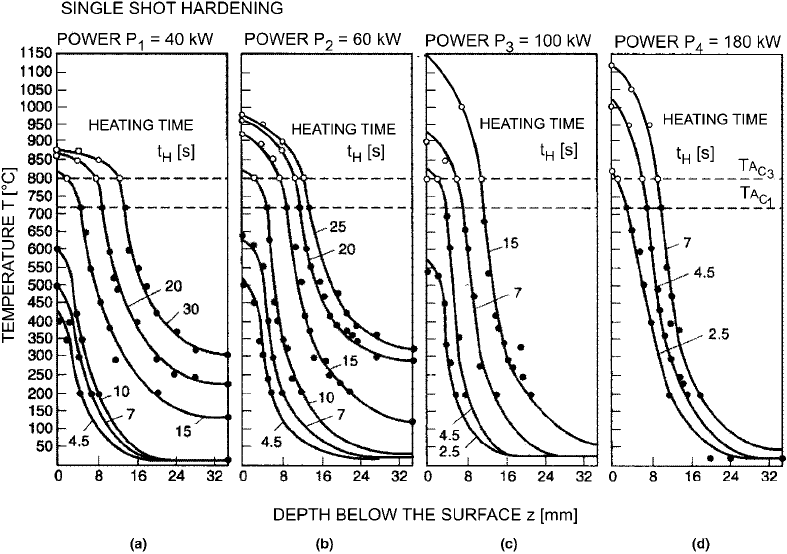
time-temperature variation at a depth of 10 mm,
it can be assumed that the specimen was heated
through the entire volume, that is, to the very
core of the specimen. Because of a different time
variation of temperature in the fourth tempera-
ture cycle, it may be concluded that the maxi-
mum temperature obtained in the depth of
10 mm is lower than the magnetic transforma-
tion temperature of the given steel. Because of
strong overheating of the cylindrical specimen
toward its center, lower temperature gradients
occur, which result in a reduction of thermal
stresses during the heating process. According to
a comparatively high temperature in the core,
temperature gradients between the surface and
the core are generally lower, which produce a
decrease in axial internal stresses generated
during quenching and also a decrease in axial
residual stresses.
Figure 39 shows the time variations of
through-thickness temperature in single-shot
induction heating with high-frequency generator
powers of 40, 60, 100, and 180 kW and a
medium-frequency current (Ref 51). Charac-
teristic temperature transformations, T
A
1
and
T
A
3
, for equilibrium heating are plotted (Ref 51).
Induction heating is a very fast process; there-
fore, the temperature transformations shift to
higher temperatures. To obtain homogeneous
austenite in the surface layer, it is necessary to
heat the surface layer to the hatch-marked tem-
perature range. The results shown in the four
diagrams make it possible to draw the following
conclusions:
The heating curves differ strongly.
Only with the power of 40 kW does the tem-
perature not reach the hatch-marked tem-
perature range in 30 s.
With all other powers higher than 60 kW,
the hatch-marked temperature range is
reached in a shorter heating time.
With all powers higher than 60 kW, more
intensive heating of the surface layer occurs,
which is shown in a steeper hardness curve in
the hatch-marked temperature range.
The first question raised by an engineer would
be how to evaluate the through-thickness var-
iations of hardness and residual stresses with
reference to the time variation of temperature.
Fig. 39 Time-temperature variations in single-shot heating at various powers. Source: Ref 51
448 / Failure Analysis of Heat Treated Steel Components
Name ///sr-nova/Dclabs_wip/Failure_Analysis/5113_417-501.pdf/Chap_13/ 18/8/2008 4:01PM Plate # 0 pg 448
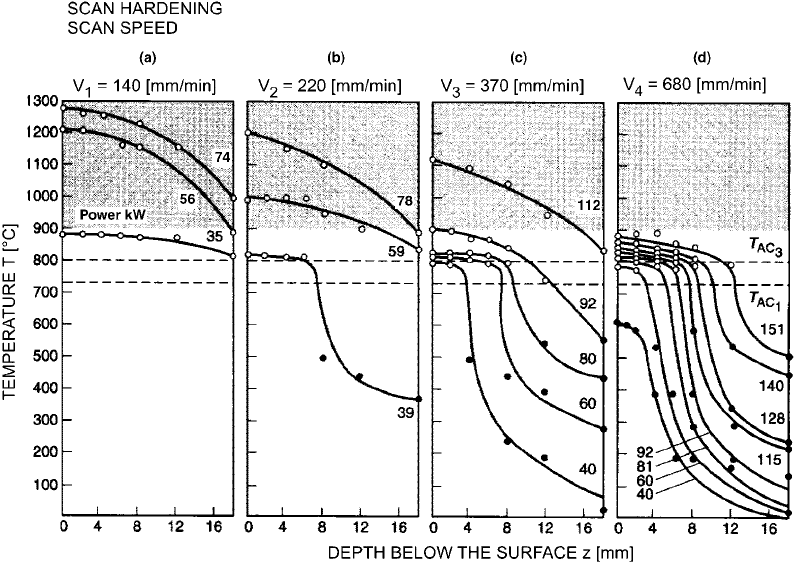
The second question would be how to select
induction-heating parameters to obtain optimal
properties of the surface-hardened layer with
a minimal energy input. In answer, the initial
steel microstructure must be taken into account
and an appropriate quenchant selected to en-
sure a cooling rate in the surface layer equal to
or a bit higher than the critical cooling rate
required.
Figure 40 shows the time and through-thick-
ness temperature variations of the specimen on
heating with different powers and different
velocities of workpiece movement, that is,
v
1
= 140 mm/min (Fig. 40a), v
2
= 220 mm/
min (Fig. 40b), v
3
= 370 mm/min (Fig. 40c),
and v
4
= 680 mm/min (Fig. 40d), in scan hard-
ening (Ref 51). In the first case, with v
1
, the
hardened layer is obtained with the powers of 74
and 56 kW. In the second case, with a higher
velocity of movement, v
2
, the hatch-marked
temperature range is reached only in heating
with the powers of 78 and 59 kW. In the third
case, with v
3
, the hatch-marked temperature
range is reached only in heating with the power
of 112 kW, whereas in the fourth case, with
the highest velocity, v
4
, this temperature range is
not reached in spite of a very high power,
151 kW.
Quenching Systems for Induction
Hardening
Control of the quenching process of a gear
wheel from high hardening temperatures
ensures martensite microstructure. The cooling
rate should be high enough to prevent formation
of unwanted softer microstructures, such as
pearlitic or bainitic ones; therefore, it is very
important that in the development of new sys-
tems of induction hardening, quenching systems
are designed properly.
Process parameters should be accurately
controlled to ensure permanent and reproducible
results after hardening of machine parts. It is also
indispensable to define individual parameters
and determine their permissible deviation in
operation, presuming that the deviations have a
negligible influence on the results of heat treat-
ment. The quenching system for induction hard-
ening is defined by eight parameters (Ref 17,
Fig. 40 Time-temperature variations in scan hardening at various scan speeds. Source: Ref 51
Induction Hardening / 449
Name ///sr-nova/Dclabs_wip/Failure_Analysis/5113_417-501.pdf/Chap_13/ 18/8/2008 4:01PM Plate # 0 pg 449
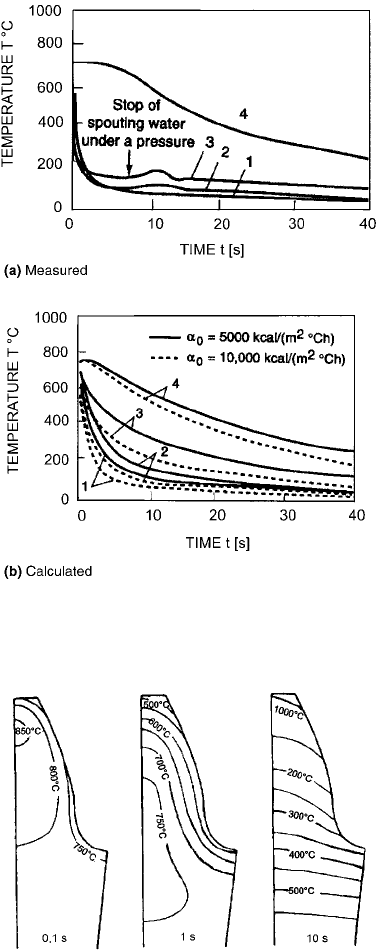
52): heat time/scan rate, power level, power
frequency, part position/rotation, quenchant
concentration, quenchant flow, quenchant tem-
perature, and quenching time.
Important simultaneous changes of one or
more of these parameters can produce unwanted
effects on the workpiece, which, in extreme
cases, result in an unsuitable microstructure, de-
viations in the depth of the hardened profile,
unsuitable hardness variation (too low hardness,
soft spots), and exceeding the distortion of the
machine element.
In practice, there are machine parts of differ-
ent shapes and sizes, requiring different depth of
the hardened layer. In these cases, the type of
material chosen and its through hardenability
should be considered.
Thus, with alloyed steels having good through
hardenability and/or machine parts with a com-
paratively thin hardened surface layer, the mar-
tensite microstructure can be obtained without
the application of a quenchant. In such cases,
heat sinks from the surface into the cold work-
piece core, so that the critical self-cooling rate
obtained at the surface is higher than the critical
cooling rate (Ref 24, 53).
Figure 41(a) shows the time variation of the
temperature measured at the individual mea-
suring points of the gear-wheel tooth during
quenching with a pressurized water jet (Ref 52).
Data on the temperature variation show that
the cooling temperatures were very similar at
measuring points 1 and 2, somewhat lower at
measuring point 3, and the lowest at measuring
point 4, where, after 40 s of quenching, it still
equaled approximately 350
C.
Figure 41(b) shows the calculated time var-
iation of temperature at the same measuring
points of the gear-wheel tooth during quenching,
taking into account selected heat-transfer coef-
ficients, a
0
, of 5000 and 10,000 kcal/m
2
Ch
(Ref 52). The calculated time variations of
temperature differ from the measured ones only
at those measuring points with higher cooling
rates. The time variation of temperature refers
only to the selected measuring points; therefore,
assessment of the stress state during the quen-
ching process and the distortion of gear-wheel
teeth or a tooth is very difficult.
The authors focused on an analysis of the con-
ditions during the quenching process by means
of a calculated distribution of temperature,
shown as isotherms (a
0
= 5000 kcal/m
2
Ch)
at the half-cut of the gear-wheel tooth. Figure 42
shows the variation of isotherms during the
quenching process after 0.1, 1.0, and finally 10 s
of cooling (Ref 52).
In quenching, it is very important that the
temperature gradients are high enough to pre-
vent plastification, that is, distortion, of the gear
wheel. Such quenching conditions, including
high-temperature gradients, result in a decrease
Fig. 41
Temperature profiles of tooth gear at given measur-
ing points during cooling process. (a) Measured. (b)
Calculated. Source: Ref 52
Fig. 42
Temperature distributions during the cooling
process. Source: Ref 52
450 / Failure Analysis of Heat Treated Steel Components
Name ///sr-nova/Dclabs_wip/Failure_Analysis/5113_417-501.pdf/Chap_13/ 18/8/2008 4:01PM Plate # 0 pg 450
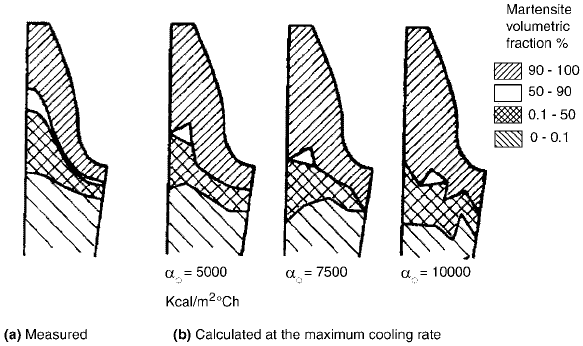
in favorable compressive residual stresses after
hardening. It follows that a sufficiently high
cooling rate must be ensured at the tooth surface
as well as at the required depth of hardening. That
means that temperature gradients in the gear-
wheel tooth must be attained so that gear-wheel
teeth are hardened with the minimum required
cooling rate, ensuring the required martensite
transformation. A sequence of images showing
isotherms in very short time intervals from the
beginning of quenching allows assessment of the
size of distortion of the tooth and residual stresses
to be expected after quenching.
Figure 43(a) shows the measured volume-
fraction distribution of martensite and Fig. 43(b)
the calculated volume-fraction distribution of
martensite when different values of the heat-
transfer coefficient, a, that is, 5000, 7500, and
10,000 kcal/m
2
Ch, are taken into account (Ref
52). The main difficulty encountered in the cal-
culation is how to determine the heat-transfer
coefficient to obtain a description of real quen-
ching conditions. Quenching is very intensive,
since it is carried out under a pressurized water-
jet; the gear wheel has been induction heated,
whereas the core is cold.
Two common quenching methods that use a
quenchant are spray quenching and immersion
quenching. Particularly popular spray quenching
techniques that offer different possibilities are:
Spray with progressive scan heating (scan
hardening)
Spray after heating in position (single-shot
hardening)
Spray quenching out of location after
heating
Spray quenching is carried out immediately
after heating with a short pause. It is used with
machine parts made of steels with good hard-
enability and with a comparatively thin hard-
ened layer. Immersion quenching is carried out
after the inductor has been disconnected from
the high-frequency generator. Gradual hard-
ening is very efficient and prevents the influence
of inverse heat from the core toward the surface,
so that no reverse heat flow and no heating of the
already cooled surface occur. This problem is
characteristic of large parts, where the work-
piece surfaces should be hardened selectively.
In the past, straight oils and water-soluble oils
were used for quenching after surface induction
heating. Straight oils and water-soluble oils
produce mild quenching effects, which reduce
difficulties due to distortion and/or crack initia-
tion.
Straight oils require immersion quenching
to minimize the risk of oil ignition, whereas
water-soluble oils are more suitable for spray
quenching. Other quenchants used are water,
polymeric water solutions of different con-
centration, water-soluble oils, saltwater, and
so on.
Polymeric water solutions are inflammable
quenchants. They are prepared in various con-
centrations to be suitably adapted to various
cooling rates. For spray quenching, various flow
rates of quenchants can be selected. They
depend on the size of inlet openings and the
Fig. 43 Martensite distribution of the hardened tooth gear. Source: Ref 52
Induction Hardening / 451
Name ///sr-nova/Dclabs_wip/Failure_Analysis/5113_417-501.pdf/Chap_13/ 18/8/2008 4:01PM Plate # 0 pg 451
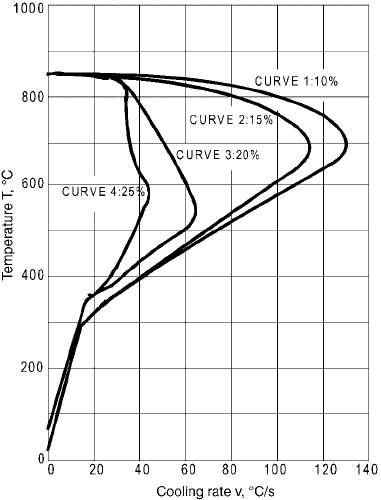
number of outlet nozzle boreholes in one, two, or
more rows at the quenching ring. The fluid flow
rate can also be regulated by pressure. Technical
literature provides data on shaping of quenching
nozzles as well as on the selection of the quen-
chant flow rate required. It is very important that
a sufficient flow rate of the quenchant is chosen
to ensure sufficient heat removal from the work-
piece surface layer during quenching.
The flow rate is also controlled by the number
of boreholes for the flow and spraying of the
quenchant, respectively. An appropriate arrange-
ment of the boreholes in the ring permits a
uniform heat removal after spray and proper
and uniform cooling. The borehole cross sec-
tions should be only 15% of the total available
ring surface and of the inductor in the single-
shot-type application, respectively. Rotation
velocities of the workpieces in surface induction
heating are relatively high and can be selected
between 800 and 1000 rotations per minute,
whereas the rotation velocity of the workpieces
during quenching is considerably lower, that is,
40 to 60 rotations per minute. Very high rotation
velocities of the workpieces are required when a
uniform and reproducible depth of hardened
layer is to be ensured, and particularly with
relatively short heating times.
Figure 44 shows the dependence of cooling
rate changes on the momentary temperature at
the workpiece surface for four different con-
centrations of polymeric water solutions (Ref
24). The selection of an appropriate concentra-
tion of the polymeric water solution for the
selected steel and the required depth of hardened
layer should ensure minimum distortion of the
workpiece, which is the final purpose of any heat
treatment. Thus, the required heat removal from
the heated surface layer of the workpiece, con-
sidering the thickness of the heated layer, should
be ensured by an appropriate quenching system.
Time Variation of Stresses and
Residual Stresses
With a certain heat treatment performed, the
required microstructural changes and an appro-
priate magnitude and variation of hardness are
obtained. It is also required that distortion of a
machine part be as small as possible so that the
final size of a machine part can be obtained with
minimum precision machining. Consequently, it
is very important that distortion be kept under
control. An appropriate machining technology
and appropriate heat treatment processes should
be selected, and internal stresses lower than the
yield stress should be ensured at any moment
and any location of a machine part during heat-
ing and/or cooling. Analytical methods provide
an insight into heat treatment conditions if the
time variation of internal stresses is monitored
and the dependence between the cooling time
and the specimen temperature at each point is
known. With regard to the specimen tempera-
ture determined in this way, the specimen yield
stress at each point can be determined as well.
Consequently, with different heat treatment con-
ditions, different values of physical quantities
can be selected. They are reflected in the chan-
ged conditions in the material, which make it
possible to study distortion of the machine part
during cooling and to determine the magnitude
of the residual stresses.
Figure 45 shows the time variation of axial
stresses at the surface and in individual depths,
that is, from 2.0 to 4.0 mm under the surface
and in the middle of a cylindrical specimen
(Ref 50).
In surface heating, tensile stresses occurred
at the surface due to thermal extension of the
Fig. 44
Polymer additive ratio effects on the cooling rate.
Source: Ref 24
452 / Failure Analysis of Heat Treated Steel Components
Name ///sr-nova/Dclabs_wip/Failure_Analysis/5113_417-501.pdf/Chap_13/ 18/8/2008 4:01PM Plate # 0 pg 452
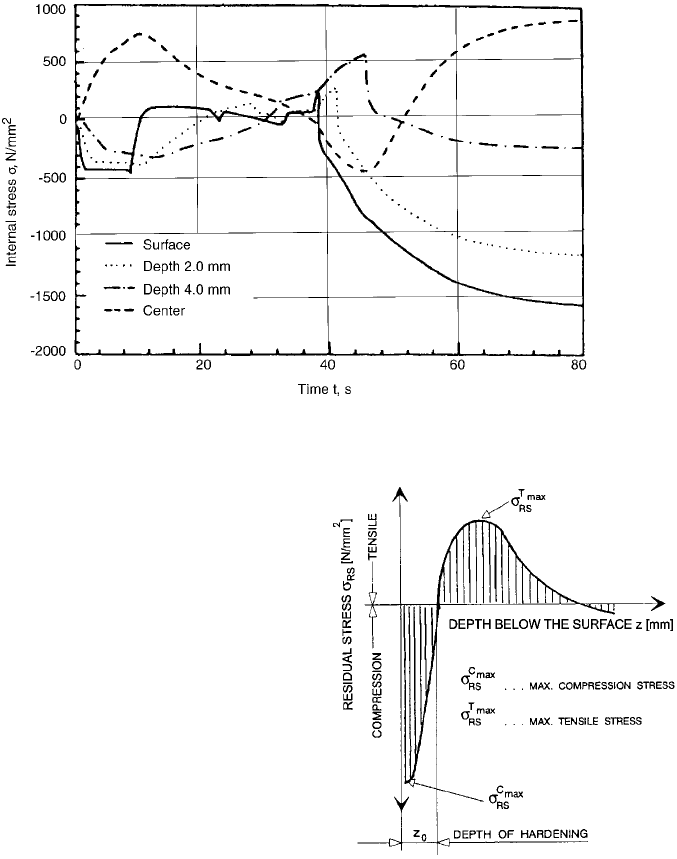
surface layer, but when the transformation
temperature of the pearlitic- to austenitic micro-
structure was exceeded, additional compressive
stresses occurred at the surface.
The compressive axial stresses transform
into tensile stresses in the zone of undercooled
austenite. In the transformation of undercooled
austenite into martensite, the compressive
stresses increase with the increase in martensite
fraction. In the core, the opposite sign of the
stress was obtained, that is, the tensile stress. At
the end of quenching, the compressive residual
stresses obtained in the surface-hardened layer
were approximately 1600 N/mm
2
, and the
tensile stresses in the core were approximately
+870 N/mm
2
.
Internal stresses are induced in heat treatment
by temperature and microstructural changes.
Residual stresses in the induction surface-
hardened layer are always of a compressive
nature, are relatively high, and have a good
effect on dynamically loaded components. The
existence of residual stresses in the radial
direction, that is, into the depth of the hardened
layer, is very important, as is the absolute value
of residual stress on the surface and the stress
profile in the transition from compressive into
tensile stresses (Fig. 46) (Ref 15).
In the case of induction hardening, a maxi-
mum compressive residual stress in the surface
layer is achieved, which is very desirable for
dynamically loaded components. The transition
from compressive into tensile stresses should be
as gentle as possible, lessening the effect of
stress concentration in loaded components. This
contributes to the fact that a machine component
is less susceptible to overloads in operation. It
has been shown that residual stresses are closely
linked to hardness variation and microstructure
in the transition zone of the hardened layer, that
is, in the narrow range between the hardened and
nonhardened microstructure.
Some examples of the dependence between
microhardness and residual stresses are shown in
Fig. 45 Axial stres s distribution at various depths below the surface during single-shot induction surface hardening. Source: Ref 50
Fig. 46
Residual stress profile below the surface after
induction surface hardening. Source: Ref 15
Induction Hardening / 453
Name ///sr-nova/Dclabs_wip/Failure_Analysis/5113_417-501.pdf/Chap_13/ 18/8/2008 4:01PM Plate # 0 pg 453
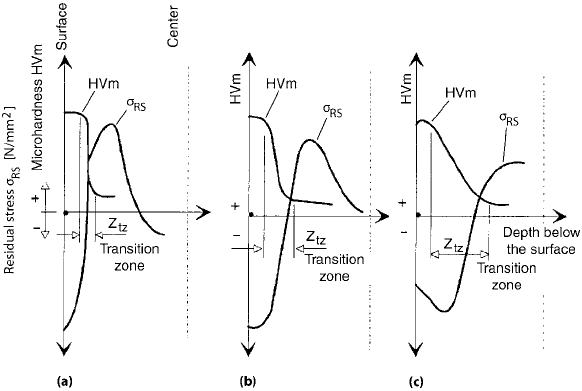
Fig. 47 (Ref 15). Figure 47(a) shows a very steep
microhardness profile in the transition zone and
the highest compressive stress in the surface,
and, related to this, a very steep transition of
residual stresses into the tensile range. The
change from compressive into residual stresses
happens at the transition between the hardened
and nonhardened areas. Figures 47(b and c)
show graphs of broader transition zones, which
produce a change in the microhardness and also
the residual stresses (Ref 15). Thus, Fig. 47(c)
shows a very slight drop in hardness in the
transition zone for the same microhardness on
the surface.
This is reflected in lower compressive stresses
in the surface, accompanied by a slight change
of stresses in the transition zone into lower
tensile residual stresses. In induction surface
hardening, the engineer should choose the kind
of heat treatment conditions that will result in
the microhardness and residual-stress profiles
shown in the last two examples in Fig. 47.
Investigations of residual stresses after induc-
tion surface hardening have confirmed that when
the hardened layer is 2 mm thick, the change of
compressive into tensile stresses happens in
compliance with the transition zone, that is,
the achieved depth of the hardened layer. When
the thickness of the hardened layer is greater
than 2 mm, the transition from compressive
into tensile stresses happens in the hardened
zone, that is, the martensite microstructure. This
means that induction surface hardening is much
more difficult if the thickness of the layer is
above 2 mm. Due to intensive cooling, the
internal stresses in the surface layer may become
so high that they cause failure of the component.
This failure is very typical, because the sur-
face layer separates from the core due to high
radial stresses. Important features on the curve
are:
Maximum value of compression residual
stress in the hardened surface layer
Maximum value of tension residual stress in
the hardened surface layer
Transition width of compression to tension
of residual stress in the hardened surface
layer
Transition steepness of compression to ten-
sion of residual stress profile
Layer depth with transition microstructure
The examples shown in Fig. 46 and 47 were
based on a presumption that the maximum
hardness and the maximum value of the residual
stresses obtained were independent from the
heating power density and the heating time
(Ref 15). In the case of induction surface hard-
ening, a maximum compressive residual stress
in the surface layer is achieved. The transition
from compressive into tensile residual stresses
should be as gentle as possible, lessening the
effect of stress concentration in loaded compo-
nents. This contributes to the fact that a mach-
ined component is less susceptible to overloads
in operation. It has been shown that residual
Fig. 47 Various residual-stress and hardness profiles below the surface. Source: Ref 15
454 / Failure Analysis of Heat Treated Steel Components
Name ///sr-nova/Dclabs_wip/Failure_Analysis/5113_417-501.pdf/Chap_13/ 18/8/2008 4:01PM Plate # 0 pg 454
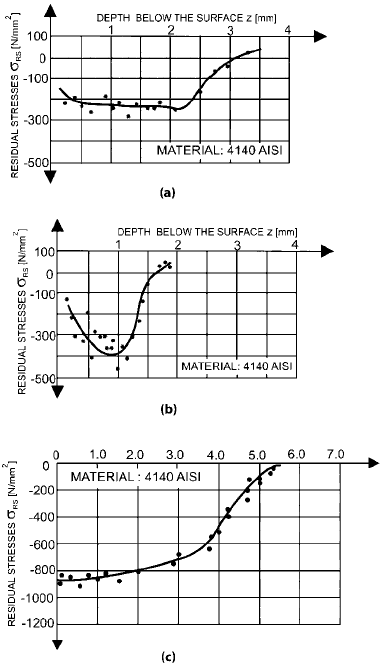
stresses are closely linked to hardness variation
and microstructure in the transition zone of the
hardened layer and base material, that is, in the
narrow range between the hardened and non-
hardened microstructure.
On the basis of the heating temperature cycle,
microstructural changes in the surface layer
after quenching can be predicted. Consequently,
the temperature cycles at the surface, that is, a
through-thickness heated layer, have a decisive
influence on the variation of residual stresses
after quenching. The variation of the tempera-
ture cycles in heating can be adjusted by the
selection of adequate energy input with refer-
ence to the steel microstructure and its thermal
properties.
Figure 48 shows three examples of induction
surface hardening, each with different energy
input during heating, whereas the quenching
process was the same in all cases (Ref 15, 54).
The variation of residual stresses after induction
surface hardening is affected by the energy input
through the workpiece surface and thermal
conductivity of the workpiece material. The
energy input in the workpiece depends on the
power chosen, the duration of high-frequency
current, the shape of an induction loop, the size
of a gap between the induction loop and the
workpiece, and the area exposed to the energy
input.
In progressive hardening, the velocity of
progression of the high-frequency loop along the
heated area must be considered.
The transition from tensile to compressive
residual stresses presents a serious danger for
catastrophic failure. From the aforementioned,
it can be understood that the workpiece must
be slowly heated and also quenched with the
correct cooling rate. The actual cooling rate is
very important throughout the martensitic trans-
formation and must be as close as possible to
the critical cooling rate. The quenching process
must be carried out very carefully in the mar-
tensitic transformation temperature range to
ensure internal stresses lower than the yield
point. The only barely-seen difference is in the
transition area, when the compressive residual
stress starts to fall rapidly. In the transition area,
the residual-stress curve is steeper and less
desirable as far as notch effects under dynamic
loads are concerned. In general, efforts should
be made to achieve low or moderate residual
stresses in the transition area after induction
surface hardening. Manufacturing engineers are
often confronted with the question of how to
obtain this kind of residual-stress profile. It
should be emphasized that because of their
lower heat conductivity, alloyed steels for sur-
face hardening are very difficult to treat, and it is
difficult to ensure desirable residual stresses in
the transition area. This is why special alloyed
steels are available that display a more favorable
behavior in heating and quenching. Because of
these difficulties, delamination of the surface to
the very core may occur. Figure 48(a) shows that
that the energy input was too weak, since only a
partial transformation of the steel matrix into
austenite occurred (Ref 15, 54). After quench-
ing, this will produce only a small portion of
martensitic microstructure, which is followed by
a measured variation of residual stresses. The
second example, shown in Fig. 48(b), indicates
that heating with a high-power density was very
intensive. The result of a too-high power density
is a distinct influence of heat conduction from
Fig. 48
Residual-stress profiles after induction surface hard-
ening at various input energies. Source: Ref 15, 54
Induction Hardening / 455
Name ///sr-nova/Dclabs_wip/Failure_Analysis/5113_417-501.pdf/Chap_13/ 18/8/2008 4:01PM Plate # 0 pg 455
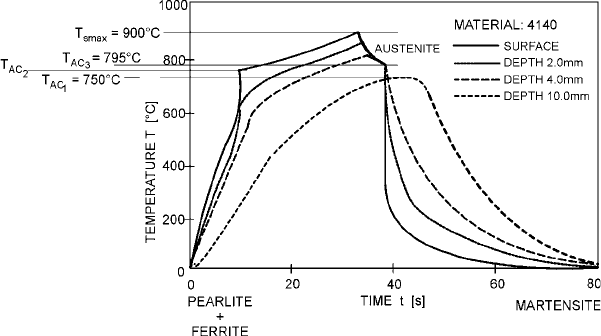
the surface to the subsurface, which, in turn,
resulted in a higher temperature measured in the
subsurface than at the surface after the delayed
interruption of heating at the beginning of the
quenching process. Because of such a heating
regime and energy input at the lower limit of
the required energy, considerably lower com-
pressive residual stresses were achieved at the
surface. In this case, the highest value of com-
pressive residual stress was obtained at a depth
of 1.0 mm. The variation of the stress was not
the most adequate, since induction surface hard-
ening can provide considerably higher com-
pressive residual stresses in the surface layer.
The anticipated variation of the residual stresses,
that is, very high compressive residual stresses
ranging between 800 and 1000 N/mm
2
,is
shown in Fig. 48(c) (Ref 15, 54).
A very favorable variation of residual stresses
can be found next to the transition zone between
the quenched and unquenched surface layers,
which ensures favorable behavior of a machine
part under dynamic loads.
In practice, the progress of heating and
quenching can be monitored by physical mod-
elling, in which case the temperature cycle at the
workpiece surface as well as the temperature
cycles in the individual depths are obtained. The
variations of the temperature cycles in heating
and the known temperatures, that is, temperature
ranges, make it possible to determine changes
of a pearlite-ferrite microstructure into an
austenitic one. The latter makes it possible to
predict the microstructure after surface hard-
ening.
The progress of induction surface heating can
be supervised by measuring the temperature at
the workpiece surface using a pyrometer. The
temperature measurement is a determination of
temperature cycles in individual depths during
induction heating and subsequent cooling. There
are three basic and important metallurgical
conditions that will affect a successful induction
surface-hardening operation:
Lower critical temperature, where metal-
lurgical phase transformation begins
Upper critical temperature, where the for-
mation of austenitic grain microstructure is
complete
Surface temperature, which affects the
resultant grain size of the heat treated micro-
structure
For a typical AISI 140 material, the steel
reference books will list T
A
1
=750
C,
T
A
3
=795
C, and T
smax
=900
C. However,
because of the shorter heating times with
induction heating, the actual values required for
a satisfactory microstructure and process may be
30 to 60
C higher than for conventional furnace
heat treatment processes.
Figure 49 shows the temperature cycles in the
surface and in the individual depths during in-
duction heating and quenching (Ref 15, 54).
The temperature range of the pearlite-ferrite
transformation into austenite, which is a con-
dition for the formation of the martensitic micro-
structure after quenching, is plotted also.
On the basis of the heating temperature cycle,
microstructural changes in the surface layer after
Fig. 49 Temperature cycles during single-shot induction surface hardening, at various depths. Source: Ref 15, 54
456 / Failure Analysis of Heat Treated Steel Components
Name ///sr-nova/Dclabs_wip/Failure_Analysis/5113_417-501.pdf/Chap_13/ 18/8/2008 4:01PM Plate # 0 pg 456
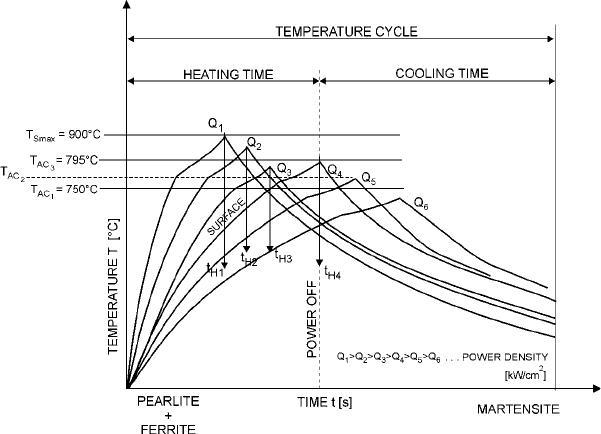
quenching can be predicted. Consequently, the
temperature cycles at the surface, that is, a
through-thickness heated layer, have a decisive
influence on the variation of residual stresses
after quenching. The variation of the tempera-
ture cycles in heating can be adjusted by the
selection of adequate power density with refer-
ence to the steel microstructure and its thermal
properties.
Figure 50 shows graphic representations of
temperature cycles at the surface at various
power densities in single-shot induction hard-
ening (Ref 15, 54). Each temperature cycle
includes induction heating, which is followed by
quenching a short while after the interruption
of heating. Four temperature cycles of induction
heating and quenching measured at different
heating power densities using high-frequency
current were plotted. With the same inductor
having the same gap width between the inductor
and the workpiece surface, but with different
power densities, different temperature cycles of
heating were obtained. With a higher power
density, the heating curve was steeper and the
heating period shorter (Ref 54).
In all cases of heating, however, the same
depth of the hardened layer was ensured. With
the given power density, however, it is more
difficult to ensure the same depth of the hard-
ened layer, since the heating times are con-
siderably reduced. With very short heating
times, it is much more difficult to ensure the
same depth of the hardened layer, which indi-
cates a worse repeatability of the results. The
shorter heating times with the same cooling
times contribute to a shorter hardening cycle and
result in higher productivity. This higher pro-
ductivity, however, entails a high consumption
of electric energy for heating and less favorable
through-thickness microhardness and residual-
stress variations in the hardened layer. Figure 51
shows microhardness and residual-stress varia-
tions with the highest power density (Q
1
) and
different heating times, t
H1
... t
H6
(Ref 15, 54).
The influence of heating time affects the
microhardness and residual-stress variations.
With a correctly chosen condition of induction
heating of the thin surface layer, adequate values
of the maximum compressive residual stresses
are obtained at the surface. The variation of
residual stresses across the hardened surface
layer, that is, in the transition zone between
the hardened and the unhardened material, is
more important. The variation should not be
steep, which means that the gradient of residual
stresses in the transition zone between the hard-
ened and unhardened material should be very
gently sloping. The microhardness variation in
the transition zone, with a gradient of residual
stresses as gently sloping as possible, can be
accomplished by selecting the given power
density and an appropriate heating time, since
Fig. 50 Temperature cycles at the surface in induction surface heating and quenching at various power densities. Source: Ref 15, 54
Induction Hardening / 457
Name ///sr-nova/Dclabs_wip/Failure_Analysis/5113_417-501.pdf/Chap_13/ 18/8/2008 4:01PM Plate # 0 pg 457
